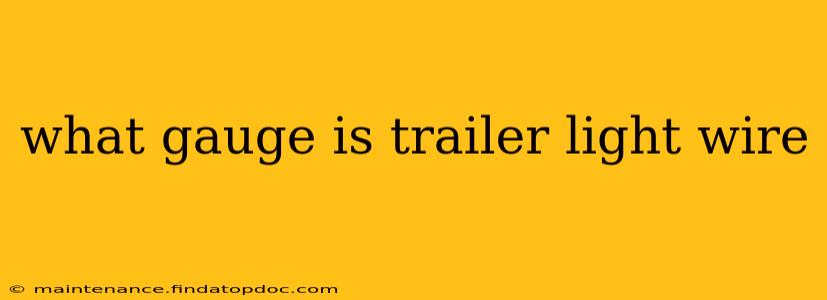Choosing the right gauge of wire for your trailer lights is crucial for safety and reliability. Using wire that's too thin can lead to overheating, voltage drops, and even fire hazards. Conversely, using wire that's too thick is unnecessary and can be more expensive. This guide will help you determine the appropriate wire gauge for your trailer lighting needs.
What Gauge Wire Do I Need for My Trailer Lights?
The most common gauge of wire used for trailer lights is 18 AWG (American Wire Gauge). This gauge provides a good balance between carrying capacity and flexibility. It's sufficient for the relatively low current draw of most trailer lighting systems. However, several factors influence the ideal gauge, including:
-
Length of the wire run: The longer the distance between your vehicle and the trailer, the thicker the gauge of wire you need to compensate for voltage drop. Longer runs require a larger gauge wire (lower number) to prevent dimming of the lights.
-
Number of lights: More lights mean more current draw, necessitating a thicker gauge wire.
-
Type of lights: LED lights generally draw less current than incandescent lights. If you're using LEDs, you can often get away with a slightly thinner gauge wire than you would with incandescent bulbs.
-
Voltage: Most trailer lights operate on 12V DC.
Why is Wire Gauge Important for Trailer Lights?
Using the wrong gauge wire can have several negative consequences:
-
Voltage Drop: Thinner wires have higher resistance, leading to a significant voltage drop over long distances. This results in dim, ineffective trailer lights, especially at the end of a long wire run.
-
Overheating: A wire gauge that's too small for the current draw can overheat, posing a significant fire risk.
-
Blown Fuses: An overloaded circuit, due to inadequate wire gauge, can blow fuses repeatedly, interrupting your trailer's lighting system.
-
Poor Connections: Using the correct wire size leads to better connections, reducing the likelihood of corroded or loose connections that can cause intermittent lighting.
What are the Different Wire Gauges and Their Applications?
While 18 AWG is common, you might encounter other gauges:
-
16 AWG: Offers a higher current capacity than 18 AWG, suitable for longer runs or systems with more lights.
-
14 AWG: Even higher current capacity, ideal for larger trailers with extensive lighting systems or heavy-duty applications.
-
12 AWG: Suitable for extremely demanding applications, typically not needed for standard trailer lights.
How to Calculate the Correct Wire Gauge?
Calculating the precise wire gauge requires considering the total current draw of all lights, the length of the wire run, and the voltage drop you can tolerate. Several online calculators are available to help you determine the correct gauge based on these parameters. Search for "wire gauge calculator" to find one that suits your needs.
What About Ground Wires?
Ground wires are equally critical. Use the same gauge wire for your ground wire as you use for the positive wire. Inadequate grounding can result in the same problems as insufficient positive wiring.
Can I Use Different Gauges for Different Parts of My Wiring?
Generally, it's best to maintain a consistent gauge throughout your trailer lighting wiring system to avoid creating bottlenecks. However, using a slightly thicker gauge for a short segment to connect a heavily loaded light is possible; however, this approach needs careful consideration. The key is to ensure that the smallest gauge segment can comfortably handle the current.
By understanding the factors that influence wire gauge selection, and carefully calculating the requirements for your specific trailer, you can ensure your trailer lighting is safe, reliable, and compliant with local regulations. Remember, safety should always be the top priority when wiring your trailer.
